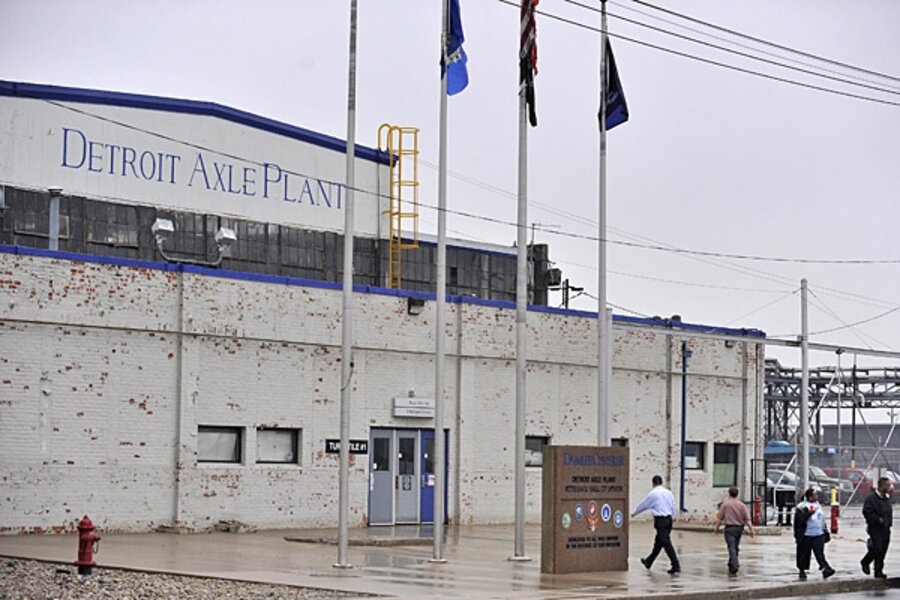In Chrysler bankruptcy, GM gets glimpse of one road ahead
Loading...
The bankruptcy of Chrysler could serve as a test case for the Obama administration as it prepares for the possibility of taking another automotive giant, General Motors, down the same path.
President Obama hopes that the Chrysler bankruptcy will be a relatively quick process that will help save thousands of US factory jobs.
One promising sign is that Chrysler has filed for a Chapter 11-style bankruptcy, from which it may emerge as a viable carmarker. A month ago, a White House task force gave a bleak assessment of the company’s prospects, and the firm appeared headed for possible liquidation under Chapter 7 of the bankruptcy code.
Even now, however, the court process for Chrysler may not prove quick or simple.
Its efforts to develop a government-backed restructuring plan have faltered on the same issue that has snagged GM – a battle with creditors who hold company bonds. Chrysler has been bargaining with creditors out of court for weeks, to little avail. If the negotiations don't go better in court, it could send an alarm signal to GM.
“At this point, it could go either way,” says Jeremy Anwyl, CEO of Edmunds.com, an automotive information service based in Santa Monica, Calif. “The next couple of weeks are really going to paint the picture of whether this is something that is quick [or not].”
For both carmakers, the goal has been to avoid bankruptcy and to win federal support for downsizing plans that could move them back toward profitability.
The risks of bankruptcy are clear. Consumers are less willing to buy a car from a company in such a condition. And for all the hopes that White House involvement will hasten the process, there’s no guarantee it will.
Delphi, the big auto-parts supplier, is a cautionary tale of how bankruptcy can last for years. The former GM subsidiary has been in bankruptcy since 2005.
Still, many creditors believe they’ll recover more of their investment in court than in deal-cutting guided by Mr. Obama’s automotive task force, which they say favors labor-union interests over those of bondholders.
But one scenario, Mr. Anwyl says, is that GM stakeholders may work harder to cut a deal before a government-imposed June 1 deadline in order to avoid following Chrysler into court. That could be the case, for example, if creditors see evidence of weak prospects in court.
The flip side, he says, is that early decisions by the judge in Chrysler’s bankruptcy could favor creditors, bolstering the view of GM bond holders that their best hopes lie in court.
“They have legal rights,” says Dan Ferris, editor of the newsletter DailyWealth.com, put out by Stansberry & Associates Investment Research in Baltimore.
In an out-of-court deal on Chrysler, not supported by all creditors, bondholders would get a $2 billion payout to relinquish their claim on $7 billion in debts.
In that deal, another of Chrysler’s creditors, a healthcare trust fund for retired Chrysler assembly workers, would trade much of its claim for a 55 percent ownership stake in the company. Italian carmaker Fiat would enter an alliance to own 20 to 35 percent of the firm.
Will that deal become the basis for a quick bankruptcy, over in a month or two?
The Obama task force hopes this will be the case. But many analysts are skeptical that things will fall into place quickly for Chrysler – or GM.
“These are enormous companies with enormous amounts of debt,” says Mr. Ferris. “I don’t believe any of this quick bankruptcy stuff. They’re both going to be pigs through a python. It’s complicated.”
The GM dealmaking has been moving along a track that’s similar to that of Chrysler, but far from identical. There’s no merger in the works, like the Fiat deal.
And in GM’s case, the government appears likely to end up owning a majority of the new firm – until the firm recovers enough that the stake can be sold.
But as with Chrysler, the sticking point has been creditors, who say the task force isn’t giving them as good a deal as they’ll get in court. At the same time, the federal government is adding some value to Chrysler and GM by its willingness to pump billions in new loans into them.
On Thursday, Obama blamed the bankruptcy on the creditors who wouldn’t sign onto the government-backed deal.
The largest Chrysler creditors had agreed, but Obama said certain hedge funds were holding out for an “unjustified taxpayer-funded bailout.”
Justified or not, the hopes of creditors for a better deal could make it very hard for GM to avoid following Chrysler into bankruptcy.
Still, bankruptcy at GM and Chrysler doesn’t have to be long and messy, says Anwyl of Edmunds.com. “We may see that a deal is actually cut that the judge just basically approves,” he says.





